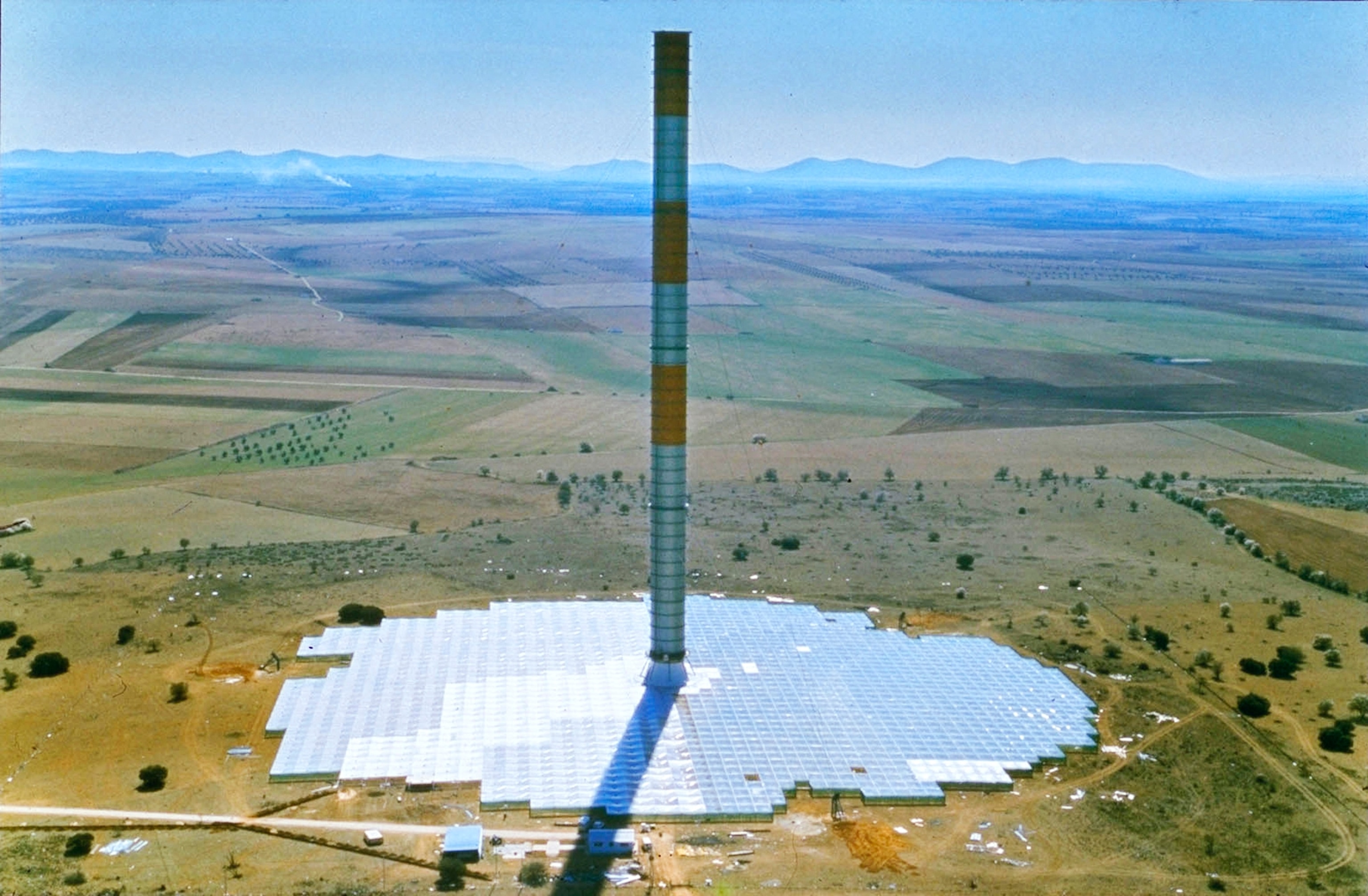
Solar Chimneys Can Convert Hot Air to Energy, But Is Funding a Mirage?
Veteran balloonist is among those eyeing solar updraft towers as an alternative to traditional panels.
Chile's Atacama Desert is as eerily beautiful as it is barren, hot, and dry. Yet this seemingly inhospitable patch of Earth might be the perfect host for a different kind of solar energy, one that has nothing to do with photovoltaic panels.
Solar updraft technology is attracting interest in desert regions worldwide in Chile, the Southwest United States, Australia, China, and the Middle East. Fueled by hot air, rather than direct sunlight, solar chimneys present a compelling prospect for producing clean, renewable energy. They also offer significant advantages over conventional photovoltaic (PV) panels—but at the moment, they face even more significant financing hurdles. (Take the related quiz: "What You Don't Know About Solar Power.")
Here's how they work: A massively large, transparent canopy, or collector, is suspended 2 to 20 meters (6 to 65 feet) off the ground, and the air beneath it, warmed by the sun, becomes hotter than the air outside. In the middle of the collector is a tall, slender tower. As the buoyant, warm air is drawn up through the tower, it passes through turbines attached to the tower's base that feed off the rising air's kinetic energy, powering a generator.
Not Just Hot Air
Solar updraft technology might sound like a futuristic power source, but the concept was first suggested 101 years ago by Isidoro Cabanyes, a Spanish army colonel.
"It's perfect for where you have lots of sun and lots of cheap, flat land," said Patrick Cottam, a doctoral engineering student at University College London's Center for Urban Sustainability and Resilience, who has become an expert on the technology for his thesis. (See related story: "As Solar Power Grows, Dispute Flares Over U.S. Utility Bills.")
The main advantage of solar updraft over PV panels, Cottam said, is "it overcomes the intermittency of solar power." It doesn't need sunlight to operate, just warm air, so it continues to churn out power after sundown. That's because the energy that's absorbed by the land when the sun is shining keeps the air in the collector warm enough at night to keep the turbines spinning.
That effect can be easily and cheaply enhanced by covering the ground with gravel or bitumen, or burying sealed bags of water just below the surface. PV solar plants cannot provide power at night unless they're equipped with expensive, complicated storage solutions that can handle very high temperatures.
Moreover, PV cells can lose much of their efficiency if they're covered by even a thin layer of dust. That's a problem in desert areas, which are not only dusty, but also very short of the water needed to keep solar panels clean. Solar towers need no water, and their canopies, which are less affected by grit, can be dusted clean without water.
So why aren't the world's deserts dotted with many hundreds of solar towers? "The capital costs are very high," said Rudolf Bergermann, co-founder of Schlaich Bergermann and Partner (SBP), a German engineering firm. He should know. SBP is currently working with another Australian company, Hyperion Energy, to built a 200-megawatt plant in western Australia that would provide electricity to tin-mining operations there. It would have a 1-kilometer (.62-mile) tall chimney made from cement and steel, and a collector 10 kilometers (6.2 miles) in diameter. And it would cost $1.67 billion to build.
That price tag is enough, Bergermann admitted, to put off potential investors for an industrial-size plant based on a technology that has not been tested widely. SBP and Hyperion are hoping for government funding, but Bergermann said he's not optimistic that public money will be forthcoming.
There is no point in building a smaller facility, according to Bergermann. A solar updraft plant "only makes sense on a large scale," Bergermann said, because the up-front costs are so high. Solar updraft is much less efficient than PV—only 1 to 2 percent of the energy that goes in to the tower gets converted into usable power, compared to PV's efficiency rate of 8 to 15 percent—but that doesn't matter.
If it is built big enough, a solar updraft plant could produce electricity at a cost per kilowatt-hour that is competitive with conventional solar power, Bergermann said, depending on the plant's financing. And because the only moving parts of a solar updraft plant are the turbines and generator, the overall cost of running and maintaining it is very low. (See also "Mojave Mirrors: World's Largest Solar Energy Ready to Shine.")
A Toppled Test in Spain
So far, there has been only one long-term test of the technology. Back in 1982, with German government funding, SBP built and ran a small, experimental 50-kilowatt solar updraft plant in the south of Spain. It consisted of a 195-meter (640-foot) tower, fashioned from corrugated steel, and a canopy 244 meters (800 feet) in diameter.
And it worked like a charm. The pilot plant was designed as a temporary structure that would last just three years, but it kept running until 1989. By then, however, its steel guy cables had rusted, and it finally toppled in a strong windstorm. "But it gave us a great understanding of the thermodynamics that we could extrapolate for use on a larger plant," Bergermann said.
SBP continued to do in-house research on solar updraft technology during the 1990s. In 2000, it partnered with Australia's EnviroMission to build a large solar updraft plant in western Australia. But the project was predicated on expected government funding that never materialized, and the partnership ended in 2004.
There is a privately owned experimental 200-kilowatt station operating in Jinshawan, China, but Bergermann said the Chinese plant's tower is too short and its collector too small to work properly. Cottam, who has visited the station, says its designer made the mistake of using glass in metal frames for the collector, and many of them cracked and shattered in the heat. "It's a nightmare," Bergermann said dismissively.
Funding woes continue to bedevil other solar updraft tower efforts. SBP's former partner in Australia, EnviroMission, is in the process of licensing its technology to a Texas company, Apollo Development. Apollo spokesman Domenic Carlucci said that, at a minimum, the company hopes to build at least three 200-megawatt plants in West Texas, each featuring a 2,400-foot (732-meter) tower, and each costing between $700 million to $800 million. Apollo is still in the process of raising funds to obtain the license and is conducting site studies, Carlucci said. (See related story: "Desert Storm: Battle Brews Over Obama Renewable Energy Plan.")
EnviroMission also hopes to build a plant in Arizona similar in size to those planned in Texas, saying it is conducting engineering feasibility studies in Arizona and is awaiting land-use permits for the plant. But a story in The Arizona Republic last June said EnviroMission was having trouble raising cash (a reported $750 million) from investors because it didn't have contract to sell the electricity to a utility. An earlier purchasing agreement with a California utility fell through because of EnviroMission's lack of certainty on financing, according to the article.
Meanwhile, EnviroMission announced in December it had signed a memorandum of understanding to partner with an unnamed "Middle East base development entity" to build "multiple" solar towers in the region. The timeline for all of these projects remains unclear, given the funding challenges.
The Balloonist and the Observatory
Now a new and decidedly unexpected player has entered the field, saying he thinks he can dramatically reduce the cost of building a solar chimney. Using fabric.
Per Lindstrand, a Swedish aeronautical engineer and record-holding balloonist, thinks his British company, Lindstrand Technologies, can erect a kilometer-tall, inflatable tower that would cost just $20 million to build. Of course, the cost of the tower typically represents only a quarter of the total cost of a solar updraft facility, according to Bergermann. So, in the case of an entire plant that costs $800 million to build, $200 million of that figure would go toward erecting the tower. Knocking that amount down by $180 million would indeed amount to pretty decent savings.
Lindstrand's interest in building a solar chimney goes back a couple of years, when he was approached by a man in Chile's Atacama Desert with a particular power problem to solve. David Rabanus, instrument group manager at the ALMA (Atacama Large Millimeter/Submillimeter Array) Observatory, helps manage a cutting-edge radio telescope project that runs on fossil fuel.
The $1.3 billion observatory, an array of 66 highly precise antennas designed to peer back billions of years to when the first stars and galaxies were formed, sits 5,000 meters (16,400 feet) above sea level in the Atacama. Its off-grid desert location requires the observatory to truck in diesel and natural gas for generators that provide the power required to shoot radio signals deep into space. (See more about ALMA: "Cosmic Dawn.")
Trucked-in fossil fuel is neither a cheap nor a clean solution, a problem not lost on ALMA's Rabanus. A couple of years ago, he stumbled across an article about SBP's Spanish project. The fact that a solar updraft plant could run 24/7 without water was, to him, a big selling point, because there's precious little water in Atacama. (See related story: "Solar Micro-Grid Aims to Boost Food and Power in Haiti.")
The region is also earthquake-prone, which is why the observatory also needs a power plant that's more robust than solar panels. But Rabanus also recognized that erecting a 1,000-meter (3,280-foot) cement-and-steel tower in a seismic zone wasn't a great idea, either. That's when he got to thinking about an inflatable tower, one that could easily withstand nearly any size temblor. That idea led him to Lindstrand. "I reached out to Per because he's a problem-solver and because of his experience in building aerostats," Rabanus said.
Lindstrand quickly warmed to the notion. He liked the challenge of "taking on mission impossible in fabric engineering." Cottam, who had recently gotten his master's in engineering from Warwick University, was at the time working part-time at Lindstrand Technologies. When Lindstrand asked him if he wanted to undertake a feasibility study for an inflatable solar chimney, he readily agreed.
A Fabric Tower: Written in the Stars?
Initially, Cottam got funding from both Lindstrand and University College London. He also won a coveted industrial fellowship grant from the Royal Commission for the Exhibition of 1851. This gave Cottam a total of £65,000 ($107,900), enough funding to spend four years researching how best to build an inflatable solar chimney. He expects to finish the research next year.
No one else is working on a fabric tower, Cottam said, but there is a small amount of academic research into solar updraft technology taking place at a few universities around the world. Cottam, meanwhile, is currently conducting tests on a 3.5-meter (11.5-foot) prototype to help him design a tower that can defend against wind loading. Next, he plans to build and conduct tests on a second, larger prototype that's between 10 and 20 meters (33 and 65 feet) tall.
Cottam's working concept is a modular design. His tower, steadied by guy wires, would consist of panels of fabric separated by helium-filled, doughnut-like rings. If the winds around it get too strong, the tower could be temporarily deflated. If a panel sustained a leak, it could be lowered to ground level for repairs. Cottam's current prototype is made from octax, a material not dissimilar to that of a potato chip packet. He's not yet sure what material would be used for the final tower, though he knows it would have to endure eight to 20 years in a tough environment, weathering both sand abrasion and harsh UV light.
If all goes to plan, Lindstrand hopes to build a 180-megawatt plant at ALMA that would feature the kilometer-tall chimney, and a collector 7 kilometers (4 miles) in diameter fashioned from some sort of polymer film. Rabanus says the observatory needs only a 3-megawatt plant, but the additional power could easily be sold to nearby mining operations.
Bergermann, however, is skeptical that Lindstrand can do it. "[Lindstrand's] cost estimates are way too low. An inflatable membrane tower can be done, but economically, it's not feasible," he said, mainly because it would probably require developing a new type of material that would likely be very expensive.
Lindstrand remains undaunted. "I can't think of anything cheaper to build. There is nothing expensive in building it, no unique components." He stresses, though, that he won't formally approach the European Southern Observatory, the 16-nation coalition that is ALMA's main operator, until he feels he has a design for an industrial plant that's commercially viable.
But Lindstrand believes that moment could arrive relatively soon: He is, after all, a veteran balloonist who knows how to take advantage of prevailing winds."There is good reason to believe it will happen, because we have momentum now," he said.
(See related story: "Ford Solar Car at CES 2014 and Past Sun-Power Vehicles.")
This story is part of a special series that explores energy issues. For more, visit The Great Energy Challenge.








